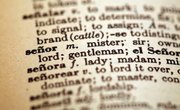Unlike most other languages, Hebrew, like Arabic, does not have letters in its alphabet to represent vowel sounds such as ah, eh, and oo. (The Hebrew letter vav can represent oh or oo, but you will not necessarily see a vav whenever those sounds are written.) Rather, the vowel sounds are represented by a system of dots and dashes known as nikud (nih-KOOD). The individual dots and dashes are called nikudot (nih-koo-DOTE). Beginning learners and children read Hebrew with the nikudot included, but written materials for adults -- such as newspapers, highway signs, novels and shopping lists -- are written without the vowel symbols. The only way to become adept at reading Hebrew without nikud is to become fluent enough in the language that you can anticipate the meanings and pronunciations of words from their grammatical structures and contexts.
Learn to Read Hebrew With the Vowel Points
Take a beginners' Hebrew course. The best way to learn to read Hebrew quickly and accurately is in a Hebrew class or with a private tutor, but you can also use books and computer programs available to help you learn to read the Hebrew alphabet and the nikud.
Expand your vocabulary. As much as possible, continue taking Hebrew classes. Read children's books in Hebrew, which contain the vowel symbols. Listen to Hebrew language tapes.
Study Hebrew sentence structure. A mastery of Hebrew grammar is essential for anticipating how words are pronounced; your ability to read without vowels will increase dramatically if you can judge accurately whether a word is likely to be a noun, verb, adjective or adverb.
Study Hebrew verb forms. Hebrew verbs are conjugated in seven different "structures," called binyanim. There are three structures for active verbs, three for passive verbs, and one for reflexive verbs (for example, the word for "to dress" is different depending on whether you are dressing a child or dressing yourself). Generally, the vowel patterns within each structure remain the same regardless of the verb you are conjugating. Therefore, as you become familiar with the binyanim, you will start to notice the patterns inherent in verb pronunciations.
Practice Reading Hebrew Without the Vowels
Read children's books in translation. If you can, get copies of your favorite children's chapter books translated into Hebrew, such as Winnie the Pooh, Charlie and the Chocolate Factory, Harry Potter. Reading translations of books you already know will enable you to practice your reading skills without worrying about meaning.
Do a little at a time. If you decide to try reading a Hebrew newspaper, for example, skip the longer political articles and focus on short human-interest pieces instead. Keep looking for written material for beginners, such as online resources for Hebrew students.
Continue your coursework. Advanced Hebrew classes will introduce you to Hebrew literature written without vowels. The instructor can help you piece together the pronunciations of the words.
Account for words from other languages. Non-native speakers are often stymied by strange-looking words which turn out to be transliterations from English, Russian, Arabic, or French. For example, the Hebrew word samech-peh-gimmel-tet-yud looks like it could be "safgati" or "siptoogee" until one realizes it is "spaghetti." Keep in mind that two vavs together are meant to be pronounced as "v" in foreign words such as "video," and that a gimmel with an apostrophe after it is pronounced like the j in Jennifer, even though Hebrew technically does not have that sound.
Remember basic rules from your grammar lessons. A consonant followed by the letter yud, for example, might take the ee or eh sounds, but not an ah, oh, or oo. A word that ends with a chet probably has an ah as its last vowel sound, before the chet.
Tip
Adjectives often end with an ee or eet sound, such as leh-oo-mee (national) or chev-roo-tee (friendly). Words that end in "ism" in English or that represent large movements, often end in oot, such as yah-ha-doot (Judaism), no-tzroot (Christianity) and tzee-oh-noot (Zionism). Don't confuse the vav-tet for the "ote" sound. Since Hebrew does not have a "th" sound, a tav is often used instead, whereas a tet always is pronounced as a t. Knowing this can help you anticipate words such as "mah-tee-mah-tee-ka" (mathematics).
Warning
The actual pronunciation of various vowel symbols differs often between native speakers and those with non-Israeli accents. For example, what many beginners learn as the "ay" symbol (as in pain) is actually pronounced "eh" (as in pen). There is also a subtle difference between "ee" and "ih."
Related Articles
Writer Bio
Sarah Bronson received her Master of Arts in journalism from New York University in 2002. Since then her clients have included "The New York Times," "Glamour," "Executive Travel," "Fodor's," "The Jerusalem Report," "ESPN—The Magazine," the "Washington Times" and "Figure" magazine. Her areas of expertise include biotechnology, health, education, travel, Judaism and fashion.










